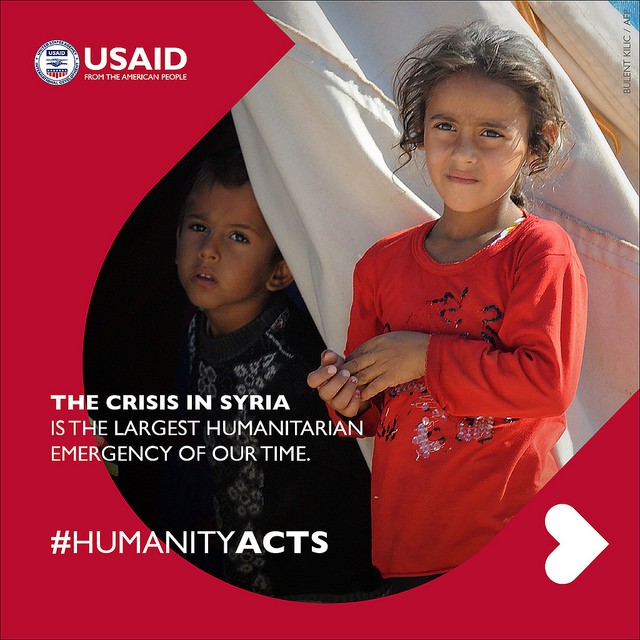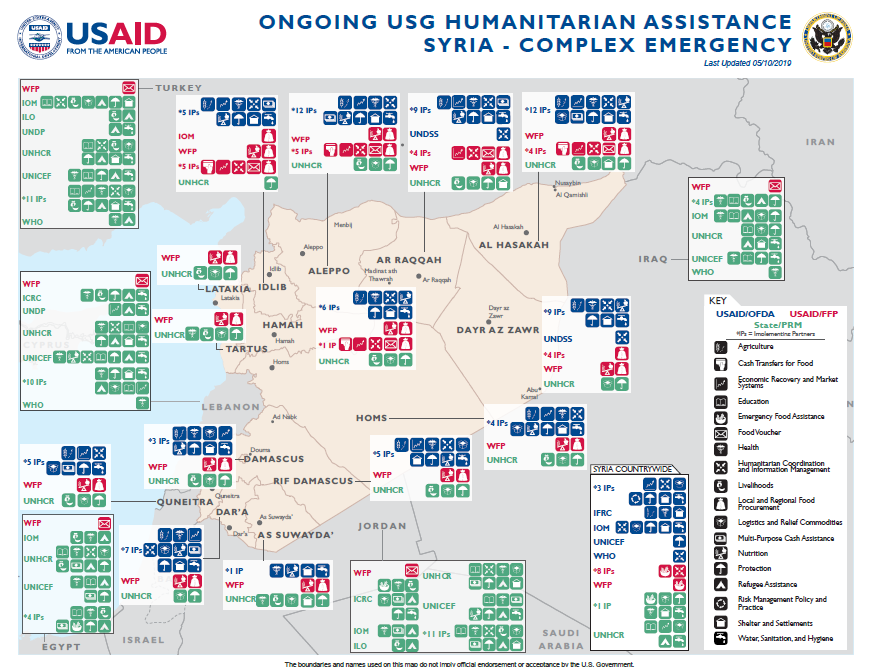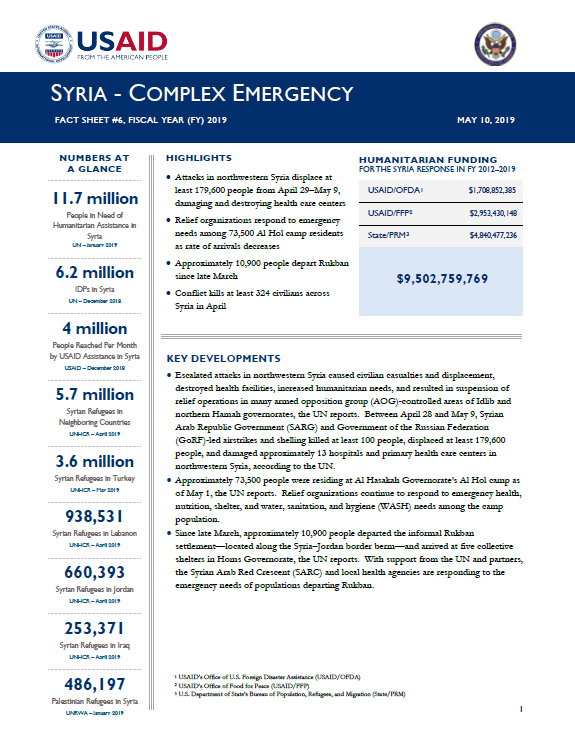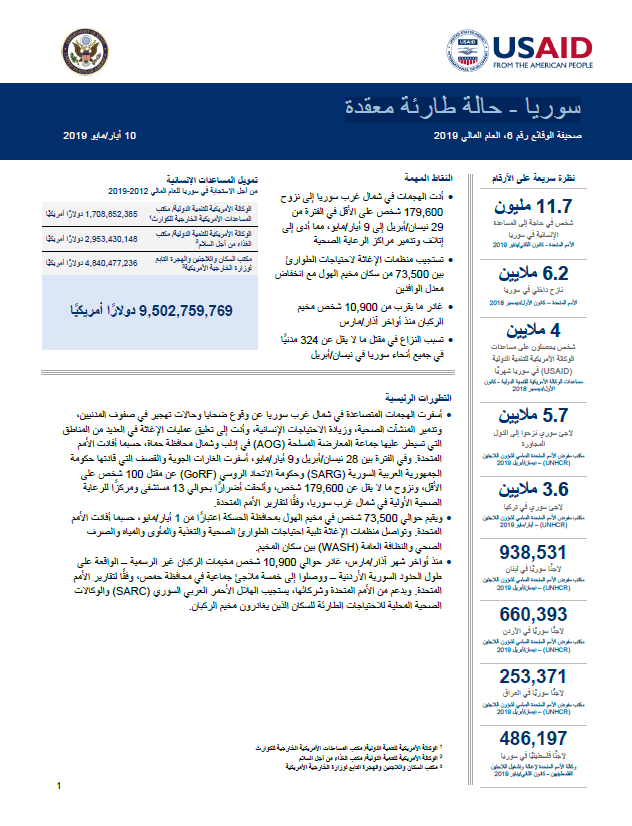- What We Do
- Agriculture and Food Security
- Democracy, Human Rights and Governance
- Economic Growth and Trade
- Education
- Environment and Global Climate Change
- Gender Equality and Women's Empowerment
- Global Health
- Humanitarian Assistance
- Transformation at USAID
- Water and Sanitation
- Working in Crises and Conflict
- U.S. Global Development Lab
Speeches Shim
May 10, 2019
Highlights
Attacks in northwestern Syria displace at least 179,600 people from April 29–May 9, damaging and destroying health care centers
Relief organizations respond to emergency needs among 73,500 Al Hol camp residents as rate of arrivals decreases
Approximately 10,900 people depart Rukban since late March
Conflict kills at least 324 civilians across Syria in April
Key Developments
Escalated attacks in northwestern Syria caused civilian casualties and displacement, destroyed health facilities, increased humanitarian needs, and resulted in suspension of relief operations in many armed opposition group (AOG)-controlled areas of Idlib and northern Hamah governorates, the UN reports. Between April 28 and May 9, Syrian Arab Republic Government (SARG) and Government of the Russian Federation (GoRF)-led airstrikes and shelling killed at least 100 people, displaced at least 179,600 people, and damaged approximately 13 hospitals and primary health care centers in northwestern Syria, according to the UN.
Approximately 73,500 people were residing at Al Hasakah Governorate’s Al Hol camp as of May 1, the UN reports. Relief organizations continue to respond to emergency health, nutrition, shelter, and water, sanitation, and hygiene (WASH) needs among the camp population.
Since late March, approximately 10,900 people departed the informal Rukban settlement—located along the Syria–Jordan border berm—and arrived at five collective shelters in Homs Governorate, the UN reports. With support from the UN and partners, the Syrian Arab Red Crescent (SARC) and local health agencies are responding to the emergency needs of populations departing Rukban.
Syria Complex Emergency - Map #6 FY19 ![]() (pdf - 456k)
(pdf - 456k)
Numbers At A Glance
11.7 million
6.2 million
4 million
5.7 million
3.6 million
938,531
660,393
253,672
486,197
Humanitarian Funding
To Syria Humanitarian Response
FY 2012 - FY 2018
| USAID/OFDA | $1,708,852,385 |
| USAID/FFP | $2,953,430,148 |
| State/PRM | $4,840,477,236 |
| TOTAL | $9,502,759,769 |
Syria Complex Emergency - Fact Sheet #6 FY19 ![]() (pdf - 679k)
(pdf - 679k)
سوريا حالة طارئة معقدة ![]() (pdf - 528k)
(pdf - 528k)
INSECURITY, DISPLACEMENT
During the month of April, active conflict and unexploded ordnances in Syria killed at least 324 people, including more than 70 children and one media worker, according to the Syria Network for Human Rights (SNHR). Casualties in April bring total civilian deaths to more than 1,100 people since the beginning of 2019, SNHR reports. Due to access and security constraints prohibiting data collection, SNHR cautions that the actual death toll may likely be higher.
Population displacement in Syria remains fluid. UN agencies recorded nearly 110,000 internally displaced person (IDP) movements countrywide during the month, representing an approximate 15 percent increase compared to the more than 95,700 people displaced in February, according to the UN. Meanwhile, approximately 34,300 IDPs returned to areas of origin. The majority of individuals in March returned to Aleppo, Dar’a, and Hamah governorates, the UN reports. Meanwhile, limited numbers of refugees continue to return from neighboring countries, including Egypt, Iraq, Jordan, Lebanon, and Turkey. Between January and March 2019, the Office of the UN High Commissioner for Refugees (UNHCR) verified an estimated 21,600 Syrian refugees who had returned to areas of origin.
Northeastern Syria
Populations fleeing conflict between the Syrian Democratic Forces and Islamic State of Iraq and Syria in Dayr az Zawr Governorate continued to arrive at Al Hol during April, increasing the camp population to approximately 73,500 people as of May 1, according to the UN. However, the rate of new arrivals continued to decrease in early April, with approximately 170 people arriving per week, compared to 500 people arriving per week in late March. Critical needs requiring humanitarian intervention persist, particularly for health, nutrition, protection, shelter, and WASH services.
Northwestern Syria
Violence in northwestern Syria continues to endanger and displace civilians, with GoRF and SARG artillery shelling escalating across Idlib and northern Hamah in early May. Between April 28 and May 9, conflict resulted in at least 100 civilian deaths and 300 injuries, according to the UN. During the same time period, insecurity displaced at least 179,600 people, contributing to a total of more than 318,000 people displaced from northern Hamah and southern Idlib since February, the UN reports. At least 16 humanitarian organizations had suspended operations in the area as of May 6.
Southern Syria
Due to the continued deterioration of conditions at Rukban, approximately 7,660 people departed the site from late March to late April, the UN reports. On May 2, an additional 3,200 people left Rukban, bringing the total number of departures to approximately 10,900 people since late March, according to the UN. Upon leaving the settlement, populations temporarily reside at collective shelters in Homs before transiting to areas of origin or preferred relocation; approximately 870 people remained at the shelters as of April 30. With support from UN agencies, the SARC and local health authorities are responding to the emergency needs of populations departing Rukban, providing food, health care, nutrition supplies, and relief items—such as blankets and plastic sheeting—to vulnerable individuals. As of late April, the UN estimated that 31,000 people remained at Rukban.
HEALTH AND WASH
During late April and early May, airstrikes in AOG-controlled areas of Hamah and Idlib killed at least three medical staff and damaged at least 13 hospitals and primary health care centers; all affected health facilities remained closed as of May 10, according to the UN. Prior to suspending operations, the affected health facilities provided regular services—such as emergency medical care, health consultations, pharmacy services, and surgeries—to approximately 112,000 people monthly in the region. In addition, as a result of the attacks, the health care system in Hamah collapsed; there are no functioning hospitals and only two functioning primary health care facilities as of May 6.
Humanitarian organizations continue to respond to emergency health needs of residents of Al Hol camp, providing health consultations, infectious disease monitoring, referrals to hospitals in nearby cities, and vaccinations to new camp residents who arrived in critical health and nutritional conditions, the UN reports. In addition, in mid-April relief organizations provided critical medical care through mobile and fixed health facilities to approximately 5,900 people. As of May 1, health organizations had referred approximately 600 critical cases to hospitals in other areas of Al Hasakah, overwhelming the capacity of referral health facilities, according to the UN. To meet the health needs of populations residing in Al Hol, the UN notes the need to increase the number of specialized health care professionals, including gynecologists, midwives, pediatricians, surgeons, and trauma specialists, as well as increase the number of mobile clinics and static medical points.
Relief actors continue to bolster WASH infrastructure at Al Hol, installing more than 820 latrines in recent weeks, while construction of additional latrines and showers remains ongoing. From April 17–May 1, humanitarian organizations also installed more than 1,400 water tanks and 1,100 waste disposal containers. Relief actors—including USAID partners—continue to provide more than 1.5 million liters of safe drinking water per day to camp residents through water trucking and water treatment plants. While sanitation facilities have improved, the UN notes that 22 percent of facilities need to be rehabilitated, as well as the need for the installation of an additional 1,300 showers.
PROTECTION
As of May 6, approximately 16 relief organizations had suspended programming, including protection activities, in southern Idlib and northern Hamah due to the escalation of conflict in the area, the UN reports. Three humanitarian organizations providing protection services in the region reported damage to facilities and eight non-operational service points, including child-friendly spaces, community centers, health facilities, and safe spaces for women and girls. Prior to the suspension of services at the facilities, nearly 600 people per month accessed protection services, including psychosocial support (PSS) and case management to help individuals identify and receive available services.
Relief organizations continue to identify protection needs at Al Hol, including services for unaccompanied children, case management, and PSS, the UN reports. As of April 30, protection actors had assisted at least 470 unaccompanied or separated children among the camp population and continued to conduct family tracing and reunification activities for nearly 110 children. As of early May, 12 humanitarian organizations—including USG partners—were providing protection services at Al Hol, such as child-friendly spaces, training of families fostering unaccompanied children, and gender-based violence (GBV) prevention and response activities, the UN reports. Protection actors also remain concerned about the number of camp residents lacking civil documentation, which may hinder future repatriation efforts, according to the UN. Relief actors also require additional specialized staff to meet child protection, PSS, and GBV response needs among camp residents.
SHELTER AND RELIEF COMMODITIES
Relief actors installed nearly 12,700 family-sized tents on plots in Al Hol from December to early May, the UN reports. However, the current camp capacity of 15,500 tent plots remains insufficient to host the camp’s current population in individual family shelters; camp management estimates that 21,300 tent plots are required to properly accommodate the population, the UN reports. As of May 1, an estimated 15,000 people—approximately 20 percent of the camp population—continued to reside in large communal shelters and are expected to move into family-sized tents once expansion efforts are completed.
In late March, heavy rainfall and subsequent flooding affected more than 86,800 people in an estimated 300 IDP sites in northwestern Aleppo and Idlib, the Camp Coordination and Camp Management Cluster reports. As of April 9, relief organizations had distributed more than 800 family-sized tents and 2,000 emergency relief kits to populations in affected sub-districts. In addition, USAID Office of Food for Peace (USAID/FFP) partner the UN World Food Program (WFP) provided food baskets to more than 7,900 flood-affected people sheltering in collective centers and unfinished buildings in Aleppo in early April.
Flooding in Al Hasakah in late March also damaged homes and impacted livelihoods across the governorate, affecting 118,000 people as of April 17, according to relief actors. During the first week of April, the humanitarian community distributed approximately 200 emergency relief kits and 150 ready-to-eat meals, sufficient for five people for five days, to flood-affected communities, the UN reports. Additionally, the SARC provided at least 3,000 vulnerable people with humanitarian assistance, including health care services and relief commodities.
FOOD SECURITY AND NUTRITION
Humanitarian organizations continue to provide food assistance to Al Hol camp residents. During March, food security agencies in the camp, including USAID/FFP partners, provided cooked meals to approximately 62,200 individuals, ready-to-eat rations to nearly 63,900 individuals, and daily bread and monthly food rations to at least 73,400 individuals.
The provision of nutrition services also remains a priority need among recent arrivals at Al Hol. Between mid-February and early May, health and nutrition responders treated nearly 740 cases of moderate acute malnutrition and nearly 420 cases of severe acute malnutrition (SAM), and referred more than 510 children to a nearby hospital due to SAM-related complications. Relief organizations are increasing the number of nutrition specialists operating in the camp and training community health workers to identify malnutrition cases.
With USAID/FFP support, WFP delivered emergency food assistance to approximately 3.1 million people throughout Syria’s 14 governorates—including approximately 251,000 people in 56 hard-to-reach areas in Dayr az Zawr, Homs, Quneitra, Ar Raqqah, and Rif Damascus governorates—in March. Countrywide assistance included more than 47,000 metric tons of in-kind food assistance and approximately $2 million in cash-based transfers. WFP’s March distributions represent approximately 86 percent of the UN agency’s intended target of 3.6 million people.
PUBLIC DONATION INFORMATION
The most effective way people can assist relief efforts is by making cash contributions to humanitarian organizations that are conducting relief operations. A list of humanitarian organizations that are accepting cash donations for disaster responses around the world can be found at www.usaid.gov/crisis/syria.
The USG encourages cash donations because they allow aid professionals to procure the exact items needed (often in the affected region); reduce the burden on scarce resources (such as transportation routes, staff time, and warehouse space); can be transferred very quickly and without transportation costs; support the economy of the disaster-stricken region; and ensure culturally, dietary, and environmentally appropriate assistance.





Comment
Make a general inquiry or suggest an improvement.